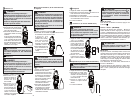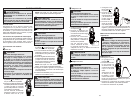
2
3
IMPORTANT SAFETY INSTRUCTIONS
WARNING READ ALL SAFETY WARNINGS AND INSTRUCTIONS.
Failure to follow the warnings and instructions may result in electric shock, fi re and/or serious
injury, as well as instrument damage and/or damage to the equipment being tested.
Save these instructions - This operator’s manual contains important safety and operating
instructions for the MILWAUKEE Clamp Meters. Before using, read this operator’s manual
and all labels on the Clamp Meters.
DANGER
Never make measurement on a circuit in which voltage over AC600V exists. Use only leads
rated 600V or better.
Do not attempt to make measurement in the presence of fl ammable gasses. Otherwise, the
use of the instrument may cause sparking, which can lead to an explosion.
Transformer jaw tips are designed not to short the circuit under test. If equipment under test
has exposed conductive parts, however, extra precaution should be taken to minimize the
possibility of shorting.
Never attempt to use the instrument if its surface or your hand is wet.
Do not exceed the maximum allowable input of any measuring range.
Only test on unenergized circuits unless absolutely necessary.
Check tool functionality on a known circuit fi rst. Never assume tool is working. Assume circuits
are live until they can be proven de-energized.
Do not ground yourself while measuring. Avoid body contact with earthed or grounded sur-
faces such as pipes, radiators, ranges and refrigerators.
Never open the Battery cover during a measurement.
The instrument is to be used only in its intended applications or conditions. Otherwise, safety
functions equipped with the instrument doesn’t work, and instrument damage or serious
personal injury may be caused.
To reduce the risk of injury from shock and arc blasts, always wear personal protective
equipment where live conductors are exposed.
WARNING
Never attempt to make measurement if any abnormal conditions, such as broken case and
exposed metal parts are found on the instrument.
Do not rotate the Rotary Dial while the test leads are being connected.
Verify proper operation on a known source before use or taking action as a result of the in-
dication of the instrument.
Do not install substitute parts or make any modifi cation to the instrument. For repair or re-
calibration, return the tool to a factory Service/Sales Support Branch or authorized service
station.
Do not try to replace the batteries if the surface of the instrument is wet.
Disconnect all the cords and cables from the object under test and power off the instrument
before opening the Battery Cover for Battery replacement.
This tool is designed to be powered by 2-AA batteries properly inserted into the MILWAUKEE
Clamp Meters. Do not attempt to use with any other voltage or power supply.
Install battery according to polarity (+ and –) diagrams.
Do not leave batteries within the reach of children.
Do not mix new and used batteries. Do not mix brands (or types within brands) of batteries.
Properly dispose of used batteries.
Do not incinerate or dismantle batteries.
Under abusive conditions, liquid may be ejected from the battery, avoid contact. If contact
accidentally occurs, fl ush with water. If liquid contacts eyes, additionally seek medical help.
Liquid ejected from the battery may cause irritation or burns.
CAUTION
Set the Rotary Dial to an appropriate position before starting measurement.
Firmly insert the test leads.
Disconnect the test leads from the instrument for current measurement.
Do not expose the instrument to the direct sun, high temperature and humidity or dew fall.
Altitude 2000m or less. Appropriate operating temperature is within -10ºC and 50ºC.
This instrument isn’t dust & water proofed. Keep away from dust and water.
Be sure to power off the instrument after use. When the instrument will not be in use for a long
period, place it in storage after removing the batteries.
Use a cloth dipped in water or neutral detergent for cleaning the instrument. Do not use
abrasives or solvents.
Functions
Dial Position Range Resolution Accuracy
Voltage DC 60/600V 0.01V/0.1V ±1.0%rdg±3dgt
Voltage AC 0.0 to 600.0V 0.1V
±1.5%rdg±4dgt (50/60Hz)
±3.5%rdg±5dgt (40~400Hz)
Current AC
0 to 600.0A
Peak 1500A
CF=2.5@600A
CF=3.0@500A
0.1A
±2.0%rdg±5dgt(50/60Hz)
±3.5%rdg±5dgt(40 ~ 400Hz)
* Add 2% at CF>2
* < 5A, add 3dgt
Current DC
(2237-20)
0-600.0A 0.1A ±1.5%rdg±5dgt
Resistance 600/6k 0.1/0.001k ±1.0%rdg±5dgt
Capacitance
0.01nF - 4000F
Auto-ranging
0.01nF/0.1nF/
0.001F/0.01F/
0.1F/1F
0.01nF-39.99nF ±2.5%±2nF
40.00nF-1000uF ±2.5%±20dgt
1000uF> ±5%±20dgt
Continuity
Cont Buzzer
0-600.0
Buzzer sounds at 35 ±10 or
25 or less
uA Current
DC uA (2236-20)
0-600.0uA 0.1uA ±1.5%rdg±5dgt
Temperature
(2236-20)
-40C - 400C
-40F - 32.0F
32.1F - 752F
0.1C
0.1F
±1.0%C ±2.0C
-40.0F to 20.0F; ±1.5%F ±4F
20.1F to 752F; ±1.5%F ±2F
Hz
Hz
Hertz (2237-20)
ACA: 40-400Hz,
ACV: 1Hz-10kHz
0.001/0.01/0.1Hz
0.001/0.01kHz
ACA: 40-400Hz ±0.5%rdg±5dgt
ACV:1Hz-10kHz ±0.5%rdg±5dgt
* Minimum Measurable inputs
are: 70 Vrms for VAC or
50 Arms for ACA
* These instruments are True-RMS sensing. All voltage and current readings are True-RMS values.

















